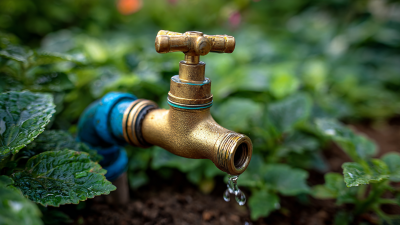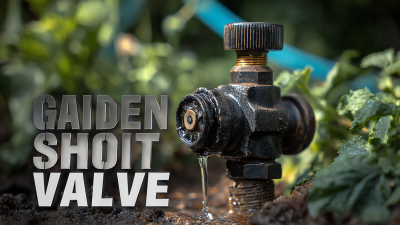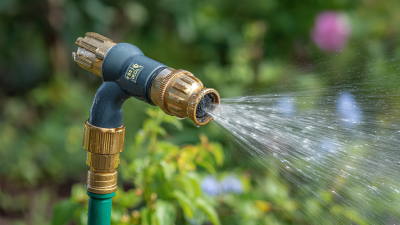In recent years, the agricultural industry has increasingly focused on enhancing irrigation efficiency and optimizing crop yields. One innovative solution gaining traction is the use of Rotating Spray Heads. These devices are designed to provide uniform water distribution while minimizing waste, thereby promoting healthier crop growth. According to a report by the Food and Agriculture Organization, effective irrigation methods can increase crop yields by up to 50%, demonstrating the significant impact that technology can have on agricultural productivity.

Expert in agricultural technology, Dr. Johnathan Green, emphasizes the importance of adopting advanced irrigation solutions, stating, "The implementation of Rotating Spray Heads not only conserves water but also ensures that every inch of soil receives the necessary moisture, directly correlating with improved crop performance." As farmers face the dual challenges of resource scarcity and rising food demand, integrating Rotating Spray Heads into their irrigation systems could be a pivotal step toward sustainable agriculture.
This article will explore the top 10 benefits of utilizing Rotating Spray Heads in agricultural applications, delving into their efficiency, cost-effectiveness, and long-term positive impact on crop yields. Through the lens of recent industry data and expert insights, we aim to highlight how these innovative devices can transform farming practices and contribute to a more sustainable future.
Rotating spray heads have emerged as a game-changer in modern irrigation systems, significantly enhancing the efficiency of water usage and improving crop yields. These advanced irrigation tools distribute water in a consistent, uniform manner, ensuring that every part of the field receives adequate moisture. This not only promotes healthier plant growth but also reduces water wastage, making them an eco-friendly choice for farmers.
Tips for optimizing the use of rotating spray heads include regularly checking and cleaning the nozzles to ensure optimal performance. Additionally, adjusting the spray pattern according to the crop type and growth stage can further enhance water efficiency. For instance, using a wider spray for established plants and a narrower focus for seedlings can maximize water coverage while preventing runoff.
Moreover, integrating rotating spray heads with soil moisture sensors can provide real-time data, enabling more precise irrigation timings. This proactive approach not only conserves water but also supports a more sustainable agricultural practice, fostering a resilient crop yield that is essential for meeting the growing global food demands.
Rotating spray heads are revolutionizing agricultural practices by significantly enhancing water distribution efficiency. These advanced irrigation devices utilize a 360-degree rotating mechanism that ensures even coverage across the crop area. According to a report by the Irrigation Association, farms employing rotating spray heads have experienced a 20-30% increase in water efficiency compared to traditional fixed spray systems. This efficiency not only reduces water waste but also promotes deeper root development in crops, resulting in healthier plants.
In addition to water efficiency, rotating spray heads are designed with several key features that optimize their performance. The adjustable flow rates allow farmers to customize the amount of water delivered based on specific crop needs and environmental conditions. Research from the American Society of Agricultural and Biological Engineers indicates that optimizing water application through these sprays can lead to yield increases of up to 15% in various crops, such as corn and soybeans. Furthermore, the ability to maintain consistent spray patterns minimizes runoff and ensures that nutrients are absorbed effectively by the soil, further enhancing the overall productivity of agricultural operations.
In recent years, the introduction of rotating spray heads in agricultural irrigation systems has brought significant advancements compared to traditional sprinkler systems. Traditional sprinklers often operate on a fixed spray pattern, leading to uneven water distribution and potential wastage of resources. In contrast, rotating spray heads utilize a 360-degree rotation mechanism that ensures a more uniform application of water over larger areas. This efficiency not only conserves water but also optimizes soil moisture levels, contributing to healthier crop growth.
Moreover, the comparative analysis of these two systems reveals a notable impact on crop yields. Studies have shown that farms employing rotating spray heads can achieve higher crop yields due to the improved water coverage and reduced evaporation losses. Additionally, the precision that rotating spray heads offer allows farmers to tailor their irrigation practices to specific crop requirements, enhancing overall productivity. As agricultural sectors face increasing pressure to maximize output while preserving resources, the shift towards advanced irrigation technologies like rotating spray heads is becoming not only beneficial but essential.
| Parameter | Rotating Spray Heads | Traditional Sprinkler Systems |
|---|---|---|
| Water Efficiency (%) | 85 | 70 |
| Average Crop Yield Increase (%) | 15 | 5 |
| Installation Cost (per acre) | $1,200 | $800 |
| Maintenance Frequency (per season) | 2 | 4 |
| Longevity (years) | 10 | 5 |
The application of rotating spray heads in agricultural practices significantly influences crop health and yield improvement. By utilizing advanced spray patterns, these innovative devices ensure an even distribution of water and nutrients, reducing areas of over-saturation or drought stress. This precision in irrigation promotes optimal soil moisture levels, which are crucial for seed germination and plant growth. As a result, crops receive a consistent supply of essential resources, contributing to healthier plants with enhanced growth rates.
Moreover, the specific spray patterns facilitated by rotating spray heads can target different crop types or growth stages effectively. For instance, delicate seedlings may require a gentle mist, while mature plants may benefit from a wider, more robust spray. This adaptability allows farmers to tailor their irrigation strategies according to the unique needs of their crops, ultimately leading to increased yields. Additionally, by minimizing water wastage and maximizing nutrient absorption, these systems support sustainable agricultural practices, contributing to long-term environmental health and productivity.
The implementation of rotating spray technologies in agricultural practices has shown remarkable success in optimizing crop yields. Case studies highlight how farms utilizing these advanced irrigation systems have experienced increased efficiency and better resource management. By precisely targeting areas that require watering, rotating spray heads minimize water waste while ensuring that all crops receive adequate hydration. This targeted approach not only improves water usage but also enhances the overall health of the crops.
In conjunction with innovative technologies like satellite-based crop monitoring systems, farmers can now access real-time data about field conditions. This capability allows for timely interventions based on specific crop needs, further enhancing the positive impacts of rotating spray systems. For instance, data-driven decisions regarding irrigation can lead to improved crop resilience and yield consistency. By combining these cutting-edge technologies, farmers are not only achieving higher productivity but also promoting sustainable agricultural practices.






